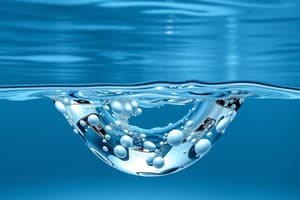Podcast
Questions and Answers
What defines a substance as a fluid?
What defines a substance as a fluid?
- It must be a gas.
- It must be a liquid.
- It has a definite shape.
- It can flow and have particles that move past one another. (correct)
How is temperature related to molecular motion?
How is temperature related to molecular motion?
- Higher temperature indicates less molecular motion.
- Temperature is solely based on the amount of substance present.
- Higher temperature results in increased molecular agitation. (correct)
- Temperature has no relation to molecular motion.
What happens to viscosity when temperature increases?
What happens to viscosity when temperature increases?
- Viscosity increases because particles are held together more strongly.
- Viscosity decreases as particles move faster and slip past each other more easily. (correct)
- Viscosity remains constant regardless of temperature.
- Viscosity can only decrease in gases, not liquids.
Which of the following is true regarding the relationship between pressure and gas particles?
Which of the following is true regarding the relationship between pressure and gas particles?
Which units can temperature be measured in?
Which units can temperature be measured in?
What is the best definition of volume?
What is the best definition of volume?
In which state of matter does volume depend on the container's size?
In which state of matter does volume depend on the container's size?
What is internal friction in a fluid commonly referred to as?
What is internal friction in a fluid commonly referred to as?
What happens to pressure when the area over which a force is applied decreases?
What happens to pressure when the area over which a force is applied decreases?
How is density defined mathematically?
How is density defined mathematically?
Which of the following factors affects whether an object floats or sinks in a fluid?
Which of the following factors affects whether an object floats or sinks in a fluid?
What is the buoyant force on an object submerged in a fluid?
What is the buoyant force on an object submerged in a fluid?
In a sealed container with a gas, what happens to pressure if the volume is doubled while keeping the temperature constant?
In a sealed container with a gas, what happens to pressure if the volume is doubled while keeping the temperature constant?
What is the formula for calculating the weight of an object?
What is the formula for calculating the weight of an object?
What happens to gas pressure when the gas is heated in a sealed container?
What happens to gas pressure when the gas is heated in a sealed container?
When the temperature of a gas is not held constant, how is the relationship between pressure and volume expressed?
When the temperature of a gas is not held constant, how is the relationship between pressure and volume expressed?
What happens to the pressure inside a sealed soda bottle left in a hot car?
What happens to the pressure inside a sealed soda bottle left in a hot car?
If the volume of a gas in a syringe increases while temperature remains constant, what happens to the pressure?
If the volume of a gas in a syringe increases while temperature remains constant, what happens to the pressure?
What is the relationship between temperature and pressure inside a gas container during transport at high altitudes?
What is the relationship between temperature and pressure inside a gas container during transport at high altitudes?
When a balloon's volume increases from 2 to 4, with temperature constant, how will its pressure change?
When a balloon's volume increases from 2 to 4, with temperature constant, how will its pressure change?
In a scenario where a container of gas has a volume of 10 and pressure of 300 at room temperature, what will happen to the pressure if the temperature increases significantly?
In a scenario where a container of gas has a volume of 10 and pressure of 300 at room temperature, what will happen to the pressure if the temperature increases significantly?
What occurs to the pressure in a gas container with a volume of 10 if the temperature increases from 30 to 90 while volume changes to 15?
What occurs to the pressure in a gas container with a volume of 10 if the temperature increases from 30 to 90 while volume changes to 15?
Why does a large inflatable ball float back up when pushed underwater?
Why does a large inflatable ball float back up when pushed underwater?
What will the density of a cube with a mass of 2 and a volume of 1 indicate about its behavior in water?
What will the density of a cube with a mass of 2 and a volume of 1 indicate about its behavior in water?
What is the relationship between volume and pressure of a gas when temperature is constant?
What is the relationship between volume and pressure of a gas when temperature is constant?
Why does the plastic toy float while the metal key sinks?
Why does the plastic toy float while the metal key sinks?
What would happen to the pressure of a gas inside a bottle when it is heated in a hot car?
What would happen to the pressure of a gas inside a bottle when it is heated in a hot car?
What is the minimum force required to push a ball with a radius of 0.2 m and mass of 2 kg underwater?
What is the minimum force required to push a ball with a radius of 0.2 m and mass of 2 kg underwater?
What does it indicate if the buoyant force is greater than the weight of an object?
What does it indicate if the buoyant force is greater than the weight of an object?
How does the density of a cube determine whether it will sink or float?
How does the density of a cube determine whether it will sink or float?
What happens to the pressure of gas particles in a container at high altitudes?
What happens to the pressure of gas particles in a container at high altitudes?
Given a box with a base area of 2 and a total mass of 50, what is the minimum height needed to keep it afloat?
Given a box with a base area of 2 and a total mass of 50, what is the minimum height needed to keep it afloat?
What is the pressure P2 when using the equation $\frac{P1}{T1} = \frac{P2}{T2}$ with $P1 = 150$, $T1 = 25$, and $T2 = 100$?
What is the pressure P2 when using the equation $\frac{P1}{T1} = \frac{P2}{T2}$ with $P1 = 150$, $T1 = 25$, and $T2 = 100$?
If the volume of an object is given as $V = A_b \cdot h$, what does $A_b$ represent?
If the volume of an object is given as $V = A_b \cdot h$, what does $A_b$ represent?
What formula is used to express the relationship between buoyant force, weight, and volume of an object?
What formula is used to express the relationship between buoyant force, weight, and volume of an object?
What is the value of buoyant force B when $\rho = 1$, $g = 10$, and $V = 32$?
What is the value of buoyant force B when $\rho = 1$, $g = 10$, and $V = 32$?
How is the mass 'm' calculated using volume 'V' and density 'ρ'?
How is the mass 'm' calculated using volume 'V' and density 'ρ'?
If the volume of a fully submerged object is 50 and its density is 1, what is the height 'h' if $V = A_b \cdot h$?
If the volume of a fully submerged object is 50 and its density is 1, what is the height 'h' if $V = A_b \cdot h$?
In the scenario where a force $F$ is calculated as $F = B - w$, what does $w$ represent?
In the scenario where a force $F$ is calculated as $F = B - w$, what does $w$ represent?
What is the final force required to push a ball underwater if $B = 320$ and $w = 200$?
What is the final force required to push a ball underwater if $B = 320$ and $w = 200$?
What volume 'V_s' of a sphere with radius 2 is calculated using the formula $\frac{4}{3} \pi r^3$?
What volume 'V_s' of a sphere with radius 2 is calculated using the formula $\frac{4}{3} \pi r^3$?
When nothing is constant and using the formula $\frac{P1 \cdot V1}{T1} = \frac{P \cdot V}{T2}$, if $P1 = 300$, $V1 = 10$, $T1 = 30$, and $V = 15$, what is $P$?
When nothing is constant and using the formula $\frac{P1 \cdot V1}{T1} = \frac{P \cdot V}{T2}$, if $P1 = 300$, $V1 = 10$, $T1 = 30$, and $V = 15$, what is $P$?
Flashcards are hidden until you start studying
Study Notes
Fluids
- Fluids are substances that can flow, including liquids and gases.
- Temperature is a measure of molecular agitation, influencing the state of matter and particle behavior.
- Viscosity is the internal friction of a fluid, determining its thickness and flow rate.
Volume, Pressure, and Density
- Volume is the space an object or substance occupies.
- Pressure is force per unit area, caused by collisions between gas particles and the container walls.
- Density is the mass of an object divided by its volume, determining whether it floats or sinks in a fluid.
Buoyancy and Weight
- Buoyancy is the upward force exerted by a fluid, allowing objects to float.
- The buoyant force equals the weight of the fluid displaced by the object.
- Weight is the downward force exerted by gravity.
- Objects float when their buoyant force balances their weight.
Temperature, Pressure, and Volume Relationship
- At constant temperature, gas volume and pressure are inversely proportional – increasing volume decreases pressure.
- Combining temperature, pressure, and volume, the relationship is expressed as:
P1 ⋅ V1 / T1 = P2 ⋅ V2 / T2.
Thermal Expansion and Contraction
- Heating a gas in a sealed container increases particle speed and collision frequency, leading to pressure increase.
- Cooling a gas in a sealed container causes the opposite effect – decreasing pressure.
Exercises
- Exercise 1: Heating a sealed bottle of soda increases gas pressure, causing expansion and potential bursting.
- Exercise 2: Objects float when their density is less than the fluid's density, and sink when denser.
- Exercise 3: Increasing volume of a gas decreases pressure at constant temperature – pressure is inversely proportional to volume.
- Exercise 4: Low temperature at high altitudes reduces gas pressure due to slower particle movements and fewer collisions.
- Exercise 5: Buoyancy pushes the inflatable ball upward, while weight pulls it down. The ball floats due to its lower density.
- Exercise 6: Density is calculated as mass divided by volume. An object with density greater than water sinks.
- Exercise 7: Using
P1 ⋅ V1 = P2 ⋅ V2, the new pressure inside the balloon is 100. - Exercise 8: Using
P1 / T1 = P2 / T2, the new pressure inside the container is 600. - Exercise 9: Using
P1 ⋅ V1 / T1 = P2 ⋅ V2 / T2, the new pressure inside the container is 1800. - Exercise 10: The buoyant force on a fully submerged stone is calculated using
B = ρ ⋅ g ⋅ VD, giving a value of 20. - Exercise 11: The minimum box height needed to keep the boat afloat is 25, calculated by equating buoyant force to weight.
- Exercise 12: The minimum force required to push the ball underwater is 120, calculated by subtracting the ball's weight from the buoyant force when fully submerged.
Studying That Suits You
Use AI to generate personalized quizzes and flashcards to suit your learning preferences.




